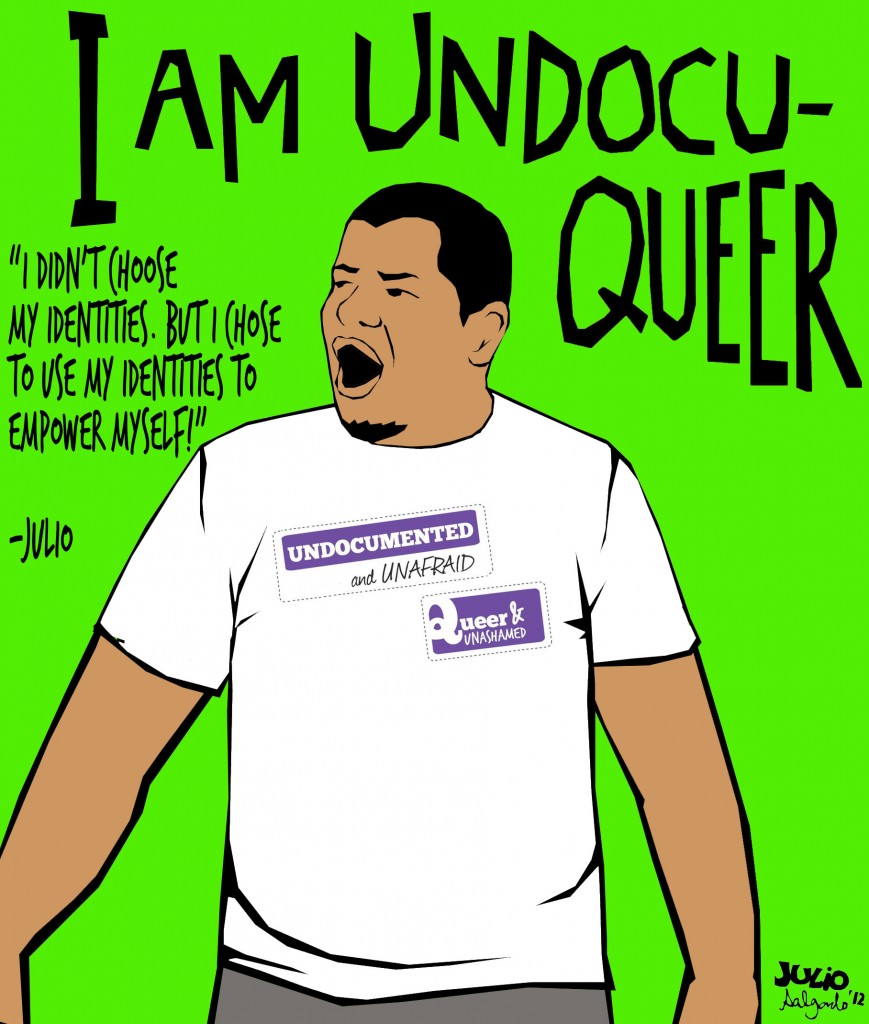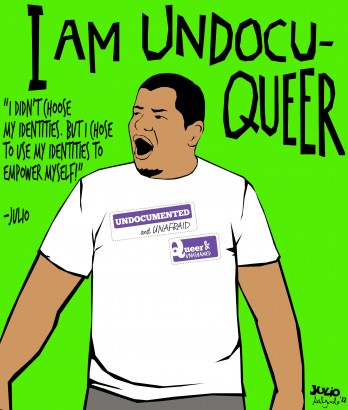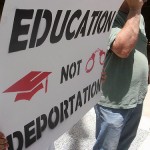Being young and undocumented can lead to complex and sometimes awkward situations. As DREAMer Angy Rivera explains in one of her videos, dating is a constant challenge when you can’t get into clubs that require a photo ID, or get to a date because you’re not allowed to drive a car.
The DreamersAdrift collective has taken these themes and translated them into the Undocumented and Awkward video series which uses humor to break through uncomfortable and often bleak scenarios. In episode 2 of the series, a DREAMer encounters a high school friend while working as a janitor at his hotel.
For many LGBTQ DREAMers, being undocumented and gay produces yet another barrier, and a second coming out. Self-proclaimed artivist Julio Salgado, co-founder of DreamersAdrift, has been cartooning his way through such anguished and uncomfortable topics. A 28-year-old Mexican immigrant, Salgado discovered his affinity for editorial cartoons as a journalism student at California State University, Long Beach.
Salgado’s family moved from Mexico to Los Angeles when he was 11-years-old. They overstayed a temporary visa when his younger sister developed chronic kidney disease, requiring a kidney transplant from their mother. He currently lives in the San Francisco Bay Area, where he is collaborating with artist Favianna Rodriguez on an art exhibit at SOMArts, and is helping her with a course on the intersection between visual art and social justice at Stanford University.
Salgado’s trademark images are bright, almost neon-colored portraits of undocumented youth accompanied by bold personal or political messages, with characters often dressed in a graduation cap and gown. His pieces often respond to current events, such as Florida Congressman David Rivera’s proposed military DREAM Act, and Yanelli Hernandez Serrano’s recent deportation.
Most recently, he has been working on a series called “I am UndocuQueer” that features portraits and quotes from DREAMers who identify as LGBTQ. One portrait of a brown-haired woman named Yahaira includes this quote: “Harmony makes small things grow, lack of it makes great things decay.” He is distributing the images online via Facebook and Tumblr, and organizations in New York, Los Angeles and Florida have already asked to use his images in workshops. So far he has done 35 portraits, and hopes the images will go viral online.
In an online video interview with Salgado, he told me about the inspiration for the UndocuQueer series, his thoughts about using visual art as a means of protest, and his own life as a queer DREAMer.
[slickr-flickr tag=”Julio_Salgado”]Q. What inspires your artwork?
A. Art is something I’ve been doing all my life. But when I majored in art in college, I didn’t fit in, so I sort of like stumbled into journalism through doing editorial cartoons. I just fell in love with the idea of telling a story, and becoming that voice of the voiceless. In a lot of the pieces that I make I use real people, key people who have been part of this whole movement. It’s important to document those stories. I think that’s why people have responded so well to them. It’s coming from someone that’s also undocumented.
Q. Have you encountered many LGBTQ DREAMers who are open about their sexuality? And, if so, does that surprise you?
A. I’ve been queer since I was little, since I can remember. But one of the people that sort of created the spark in me about two years ago was Mo [Mohammad] Abdollahi. He was one of the people that did the sit-in in Tuscon in 2010. He’s from Iran. When I heard his story, I said – this dude is willing to say ‘I’m queer and undocumented.’ I mean, he was risking deportation back to Iran, a place where homosexuality is punished with death.
So I was graduating from college at the time, and the first thing they would tell us was don’t tell anyone you’re undocumented. And here we have people revolutionizing that. It was Mo, and Yahaira Carillo, and Tania Unzueta from Chicago. So we have three queer folks who are huge parts of this movement. And I was like, “Oh my god I have to document this.” And the only way I knew how to document was through writing and through art. And so I started posting all those images online.
Q. Despite the vocal presence of a few queer activists, have you experienced homophobia among undocumented youth?
A. When I was in college, I would hear comments like “Oh you faggot,” or “Faggot this, faggot that,” or “Oh, you puto.” And it was maybe unconscious words that people were using. Online, when we’ve tried to touch these topics, I’ve seen some of reactions from certain comments like, “Oh, why do they have to be a bunch of faggots on the videos?” Somebody once called me an illegal faggot, online. And, I guess, when we started making the videos, we expected that. For the most part it’s been positive, but there is that sentiment out there.
A lot of people were saying, being gay and being undocumented are two different things. And I’ve been sort of explaining it and breaking it down. Being undocumented and being queer, I know what it’s like to be in the shadows, you know, wondering who you’re going to trust with the secret.
And I think that through art, rather than reading, you have this poster, this image, that forces you to see something.
Q. So, tell me about “I am UndocQueer.”
A. The point of the series is to create a presence for us, so that for young queer undocumented folks the idea of them being queer is not an issue anymore. For some of us, who know what it’s like to be in the closet, it’s a second coming out.
It came out of a conversation we had with an undocumented queer collective. We were talking about exactly what we wanted to tell people about being undocumented and queer. Of course, the journalism side of the brain was like, we need to document our stories. And I was like, I want to create a poster campaign, so we can give these posters to different organizations so they can have a presence, create a safe space for people.
I want this to be an interactive thing where people can print them out, make it part of a workshop. That if you’re talking about immigration, don’t forget to talk about my issues.
Q. Do you think your artivism has been effective?
A. I draw for myself – because it’s what I know how to do. I can’t vote, I’m really bad at organizing, I hate meetings, and so this is the way I do it. When I saw those people getting arrested, I was so sad, I was mad, I was crying, and I was like, “I’m going to do this.” When I started seeing that other undocumented people were putting it on their walls or they were asking me if they could get a picture, I think people really identify with it. So, I think I have. Somebody asked me if politicians see my images. And I hope they do, I hope they see them, since they are the people making decisions. I think that a big part of why people like it is that it comes from me. Nobody told me to draw like this.
Feet in Two Worlds is supported by the New York Community Trust and the John S. and James L. Knight Foundation with additional support from the Mertz Gilmore Foundation and the Sirus Fund.





